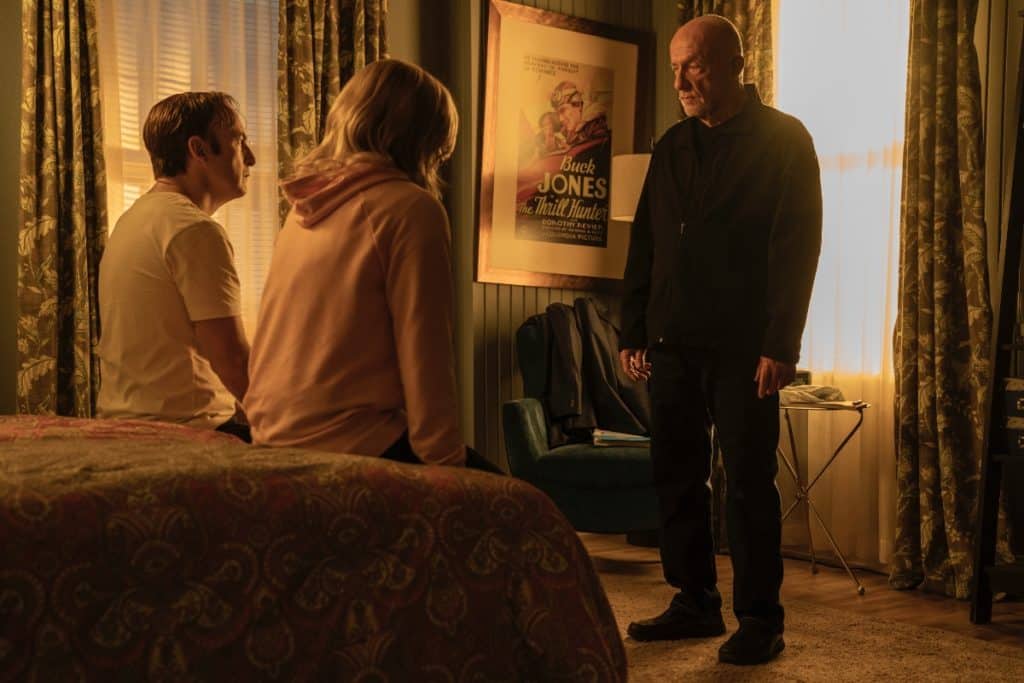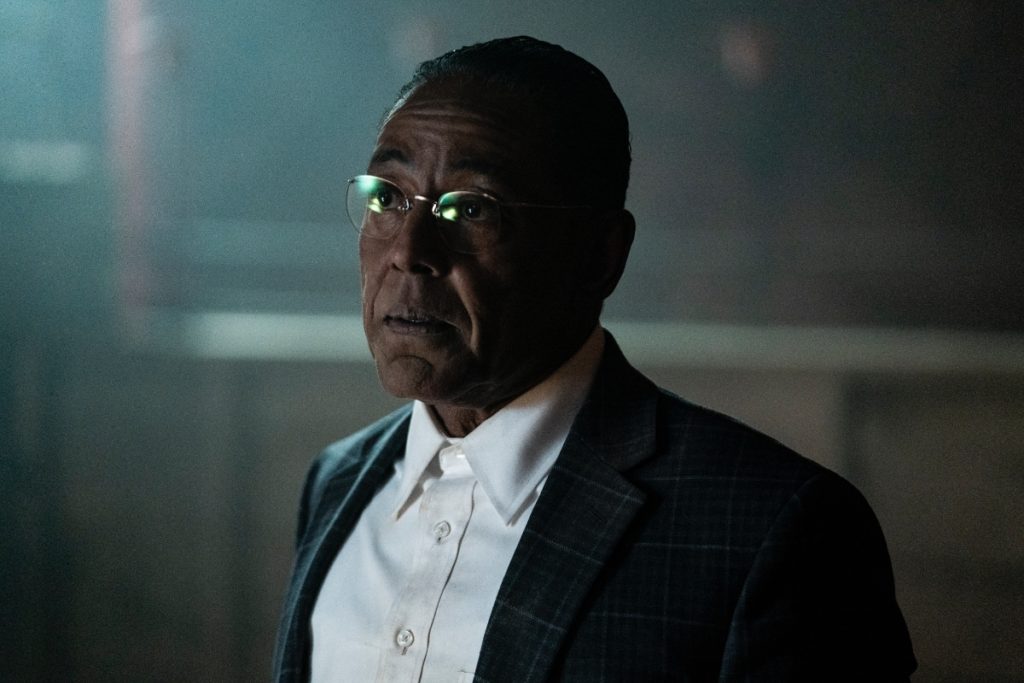Read also:
How to Watch FX Live Without CableHow To Watch AMC Without CableHow to Watch ABC Without CableHow to Watch Paramount Network Without CableLalo’s hunt for Gus Fring puts Jimmy and Kim in the line of fire in a masterclass of terror and foreboding.
Howard Hamlin (Patrick Fabian) and Lalo Salamanca (Tony Dalton) don’t have much in common. Sure, they’re both suave gentlemen. They both have a way with words when the moment calls for it. They both have a dark side that emerges when they feel disrespected or cornered. But they’re in very different lines of work. They cross very different sorts of lines. Their relationship with Jimmy McGill (Bob Odenkirk), the center of gravity in this story, couldn’t be more different, with one a predator and the other prey.
And yet, by the end of “Point and Shoot,” they lie clumped together in the same unmarked grave, equally yoked under the indifferent gaze of a stationary work light and pound after pound of dirt. All of these grand plans — Kim (Rhea Seehorn) and Jimmy’s baroque scheme to undermine Howard, Lalo’s elaborate play to take out Fring (Giancarlo Esposito), Mike’s (Jonathan Banks) clockwork operation to protect his boss — amounted to this. Two men, alike in dignity, sharing the same futile fate.
The knock on Better Call Saul is that it is essentially two shows: one about Jimmy’s misadventures in the legal system with Kim as his shepherd, and another about the rise of Gus’ empire as Mike ascends through the organization. The two halves connect in places, often more thematically than narratively, but they largely occupied different spheres.
If there is a symbolism to the closing image the season’s eighth episode offers, it’s that the separation between those two worlds dies along with Lalo and Howard in the cold, hidden ground beneath an industrial laundry. The chance to keep one side of this tale from the other is gone.

Jimmy pleads with his Salamanca captor to spare his wife. Kim goes to kill Gus under a threat on her husband’s life. Both witness a cartel hit. Both hear the riot act from Mike about how “this never happened.” Both are a part of this now. Whatever borderline existed between Jimmy’s sporadic skullduggery and this bloody, deadly business was erased with a new refrigerator, a new psychic weight to carry, and a gobsmacked promise to a parking lot attendant turned mob enforcer to stay mum. It’s a hell of a thing.
It’s also a minor miracle that the episode wrings as much tension from this long-building collision as it does. Jimmy’s trapped with a murderous Lalo and a ticking clock, but the audience knows he survives through Breaking Bad. Lalo sends his amateur assassin to take out Fring and even holds Gus at gunpoint himself, but viewers know “The Chicken Man” lives to square off with Walter White. “Point and Click” does have the benefit of the ever-present Sword of Damocles hanging over Kim Wexler, who’s conspicuously absent in later adventures. But this is a remarkable taut hour considering the players most at risk are the ones who’ll unquestionably live to see another day.
What allows Better Call Saul to succeed is the incredible performances and scoring and direction that spurs the audience to feel what these characters feel in the moment. Odenkirk and Seehorn are the unadulterated vision of disturbed, distraught civilians firmly out of their depths. The wide-eyed, shaken stare of Kim as she forces herself to do the work of a killer, only to then blurt out a dire plea for help to a veritable stranger under unfathomable circumstances, is gutting. The kindest deed Jimmy McGill may ever perform is his grand final pitch to Lalo, a prayer to send his wife to do this grisly act rather than him, giving her the chance to get away at the cost of his own life. It’s rare that Saul Goodman must keep it together, but his teary insistence to Kim, practically begging her to leave without articulating it, is no less heartbreaking.
On the cartel side, Dalton delivers one last masterclass in menace. His matter of fact air with Jimmy and Kim, and his toying, taunting tone with his bigger quarry, make for a fitting swan song to the show’s most colorful villain. By contrast, Esposito, the king of portraying impeccably polished and preternaturally calm operators, conveys a sense of abject terror in the presence of his attacker. His silent, scurrying air, that leaves him more apt to take desperate chances and make wild, lucky mistakes, show how serious and terrifying this is for Fring.

We know most, if not all, of those in danger in Better Call Saul survive. But the shaken demeanors of the normally self-assured figures in play makes us shake along with them. And the elegantly-set traps and intricate ploys make us wonder how.
The same goes for co-creator Vince Gilligan’s return to the director’s chair. “Point and Shoot” has the vibe of a Hitchcock film, with slow-spun tension filling up the space between normal-ish lives and extraordinary crimes. Gilligan and company carry that spirit with the episode’s visuals, elevating those tense moments with more of the franchise’s trademark cinematic compositions and framings.
Here, he plays with light and shadow. A freighted extra second on Gus’ porch feels that much more portentous as the trees’ shadows crest and crash upon Kim in quiet anticipation. Fring’s foolhardy move to investigate the laundry turns into a horror movie when the street lamps outside bleed through the fan vent Lalo snuck through, warning Gus that his adversary is here a moment before it’s too late. In the two men’s final confrontation, Fring makes one last ditch effort, kicking an electrical connection to bathe them both in darkness, firing blindly at his foe in the inky blackness, and emerging from a burst of light, a free man once more. The interplay of light and dark here sets the mood, and tells the story, as much as any piece of dialogue.
What allows Better Call Saul to succeed is the incredible performances and scoring and direction that spurs the audience to feel what these characters feel in the moment.
Granted, the whole confrontation plays as a bit of a cheat. Gus must be psychic, since his only answer for how he knew to hide Chekov’s gun in the superlab is “I didn’t.” Fring has the benefit of body armor, but a killer like Lalo seemingly ought to be able to fare better than he did given his upper hand, even in a blackout. But Gus’ injuries, his playing on Lalo’s desire to watch him squirm, his admission of not exactly knowing what he was doing, and his appropriately desperate act to survive still make these scenes winners, and earned enough to pass muster.
In their wake, the prime threats that have long hung over Better Call Saul are gone. Howard is an ostensible suicide — a cover-up story, meticulously orchestrated by Mike, that plays into the lies Kim and Jimmy have already been telling. Lalo will never be heard from again, with only Hector knowing he survived the assault on his home in the first place. Their deaths, their deeds, their unfortunate final moments, both “never happened,” wiped away in a few short hours.
What’s left is to live with it. The threat of police intervention hangs over the heads of Jimmy and Kim. Maybe there will be decisions over whether to seek out witness protection or keep stories straight in front of the cops. Maybe there will be continued danger or lurking this close to a war between Fring and the Salamancas that fans know doesn’t end here. Maybe the ability to balance being officers of the court and friends of the cartel will be too much to bear.
For now, though, Kim and Jimmy can only share the traumatized embrace of two people who fell deeper than they’d ever imagined and look on in horror at what they’ve wrought. Mike cannot help but crack, just a little, at the sadness of a noncombatant like Howard left to rot in some unknown pit. The personification of antagonism in these two separate realms, a sharp-tongued lawyer and an even sharper crime family impresario, are no longer breathing. They come from different places, walked different paths, but each finds their destination here. The grim to all these byzantine plots stitches their deaths and their worlds together. And the horror, the guilt, the futility of it all, remains.